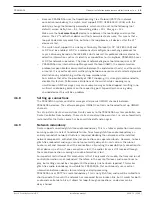
28
en | General installation procedures and instructions
PRAESENSA
2019.11 | V1.00 |
Installation manual
Bosch Security Systems B.V.
4.6.6
System size limits
OMNEO always uses synchronized play‑out times to make sure every receiver produces the
audio at exactly the same moment (with an accuracy of 1
us). The maximum distance between
two networked devices on the network depends on the configured latency of the receivers. By
default PRAESENSA uses a receiver latency setting of 10
ms, which allows for a maximum
distance between two devices in the same subnet of 500
km. The OMNEO technology allows
for a maximum receiver latency of 20
ms, which is sufficient to cover a distance of 3000
km
between devices (not yet supported by PRAESENSA).
If the distance between a transmitter and a receiver is too long for the configured receiver
latency, then the audio samples arrive at the receiver later than the instructed play‑out time.
Then the samples cannot be used anymore, resulting in no audio.
The
maximum number
of PRAESENSA network devices in a single subnet of a system is
250
devices. For smooth and fast operation of the system it is recommended to limit the system
size to
150
devices.
4.6.7
Network switches
All networked PRAESENSA devices have a built in Ethernet switch with at least two Ethernet
ports on RJ45, supporting Rapid Spanning Tree Protocol (RSTP). Because of the integrated
switches, stacked devices can be looped through conveniently with short cables. For
RSTP‑support, cable loops are allowed in the network, creating redundant connections for
automatic network recovery when a connection would fail. This is an important consideration
for emergency sound systems. No conventional star‑wiring is needed, although it is possible. A
PRAESENSA network can be expanded easily by inserting more devices in the loop or chain.
Not all Ethernet switches can be used for PRAESENSA (or any other system that is based on
Audio over IP). As part of the PRAESENSA product range a pre‑configured, managed,
multi‑port Ethernet switch is available for more connection flexibility. This switch is also
included in the PRAESENSA certification for EN54‑16 and other standards.
In case other switches or routers are to be used, consider the following important
requirements:
–
The switch must be a Gb‑switch with packet switching performed in hardware; software
switches will introduce too much jitter.
–
The MAC‑address table must have a capacity of >1000 addresses, to prevent that the
switch starts broadcasting unicast packets because it runs out of space.
–
The switch must support Quality of Service (QoS), with strict priority, through
differentiated services (DiffServ) on all ports, to ensure that PTP-synchronization and
audio packets get priority over control packets.
–
Do not use Energy Efficient Ethernet (EEE) for PRAESENSA because this breaks the PTP
synchronization, resulting in poor audio synchronization performance and occasional
dropouts. EEE is a technology that reduces switch power consumption during periods of
low network traffic. It is also known as ‘Green Ethernet’ and IEEE
802.3az.
The PRAESENSA system controller and multifunction power supply have integrated
switches, but when additional switches are needed, it is recommended to use
PRAESENSA managed switches. Otherwise, do not use unmanaged Ethernet switches
that support the EEE function, since EEE operation cannot be disabled in these switches.
For managed switches, ensure that they allow EEE to be disabled and make sure that EEE
is disabled on all ports used for PRAESENSA audio traffic.
Guidelines for selecting switches are found on the Audinate website at the following link:
Summary of Contents for PRAESENSA
Page 1: ...PRAESENSA Public Address and Voice Alarm System en Installation manual ...
Page 2: ......
Page 193: ......
















































